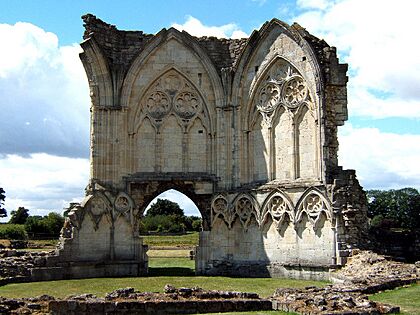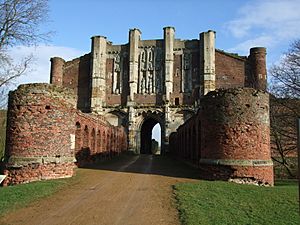Thornton Abbey facts for kids
Thornton Abbey was a large medieval abbey in North Lincolnshire, England. It is near the village of Thornton Curtis, close to Ulceby, and south of Kingston upon Hull across the Humber river. Today, its ruins are a very important historic site, known for having England's biggest and most impressive old gatehouse from a monastery.
Contents
What is Thornton Abbey?
How it Started
Thornton Abbey began as a priory in 1139. It was founded by William le Gros, a powerful earl in Yorkshire. In 1148, Pope Eugene III made it an abbey.
The abbey was home to Augustinian monks, also called canons. These monks lived together under special rules. They also helped people outside the abbey, doing important community work.
Life at the Abbey
Many different officers worked at the abbey. These included a cellarer, who managed food, and a bursar, who handled money. There was also a medieval hospital near the abbey, which started before 1322.
Thornton Abbey became very rich and important. This was because it was involved in the growing wool trade in the area. By 1534, the abbey had a large income of about £591 each year.
The Abbey's End
In 1539, King Henry VIII closed Thornton Abbey. This was part of a big event called the Dissolution of the Monasteries, when many religious houses were shut down.
However, Thornton Abbey did not completely disappear. It became a special kind of church college, called a Secular College. But these colleges were also closed down in 1547.
Thornton Abbey railway station is located nearby today.
Who Owned Thornton Abbey?
Looking After the Ruins
After the monasteries closed, many people owned the site of Thornton Abbey. These owners included important figures like Henry Randes, who was the Bishop of Lincoln. Later, Sir Robert Tyrwhitt and Sir Vincent Skinner also owned it.
In 1938, Sackville Pelham, the 5th Earl of Yarborough, gave the care of the abbey ruins to the Office of Works. Today, English Heritage looks after the site. It is open for people to visit, but you usually need to book ahead. Some inside areas are currently closed.
What Does it Look Like?
The first abbey building from the 1100s was built in a style called Romanesque. Sadly, none of this original building can be seen above ground now.
The later abbey, built in the 1200s and 1300s, was in the Early Gothic style. Not much of this building remains either. You can still see three walls of the chapter house (where monks met) and part of the cloister (an open courtyard). The outline of the abbey's original buildings is marked on the ground.
The Amazing Gatehouse
The most interesting part of Thornton Abbey is its huge gatehouse. It is one of the oldest large buildings in England made with bricks. The gatehouse stands three stories tall and is still in great condition.
It does not have many windows, and the rooms inside are quite small because the walls are so thick. On the outside, above the main gate, you can see three almost life-size statues. A bridge over a moat leads to the gatehouse. This bridge has strong walls and even old toilets, called garderobes.
The Abbot's Lodge, a building nearby, is also a very important historic site. Parts of the abbey's ground floor were turned into a house in the 1600s. However, this new structure reportedly fell down when it was finished.
Digging Up the Past
The Black Death Discovery
For a long time, Thornton Abbey was not fully explored by archaeologists. But in 2007, English Heritage started a research project. From 2011 to 2016, the University of Sheffield dug up parts of the site.
In 2013, during these digs, archaeologists found something amazing. They uncovered a Black Death plague pit in the cemetery of the abbey's hospital. This pit contained the skeletons of at least 48 people, including 27 children.
Scientists were able to get DNA from the skeletons. It showed positive for Yersinia pestis, which is the germ that caused the Black Death. This was a very important discovery. It was the first time a Black Death mass grave was found in the countryside in Britain, not just in big cities. This find helps us understand how difficult it was for small communities to deal with such a terrible disease.
Important People Buried Here
Some important people were buried at Thornton Abbey, including:
- William le Gros, 1st Earl of Albemarle
- Aveline de Montfichet, who was the wife of William de Forz, 3rd Earl of Albemarle




